Panduranga Rakhumayi Temple
For some Namasankirtan is divine music. For others it’s the ultimate truth. The sacred scriptures hold Namasankirtan in the highest pedestal.
Srimad Bhagavatham says “Kalau Sankirtaya Kesavam”, while Purandaradasa sang “Kaliyugadalli Harinamava Nenedarey Kula Kodigalu Utharisuvavu”. Adi Sankara Bhagwadpada taught “Bhaja Govindam, Bhaja Govindam – Govindam Bhaja Moodamathae”, while Sri Bodhendra Saraswathi Swamigal, a descendent in the lineage of Adi Sankara emphasised, “Namasankirtan alone is the salvation in this Kali Yuga”.Azhwars and Nayanmars sang the praise of the Lord throughout their lives in order to attain moksha(liberation).
Many saints born in Maharashtra sang Abhangs (devotional poetry in Marathi language) in praise of Sri Krishna, who is popularly known as Vitthal . The Lord is also hailed as Panduranga and his consort is Rakhumayi Devi.
Swami Haridhos Giri propagated the holy name of Lord Panduranga throughout the world and built a huge ashram and temple complex in Tamil Nadu. In the ashram complex, he built a temple for Lord Panduranga along with Rakhumayi Devi. The temple has its origins in a divine dream. During one of his tours in the state of Maharashtra, Swami Haridhos Giri stayed overnight in the village of Mangalwadi. He had a dream in which his Guru Swami Gnanananda Giri appeared and commanded him to proceed to Pandharpur immediately. Without a second thought, he proceeded to Pandharpur. Miraculously, the chief priest of the Pandharpur temple also had a dream in which Lord Panduranga advised the priest to give Swami Haridhos Giri a small idol of himself. This small idol had apparently been donated by a childless couple and was kept in the sanctum sanctorum of the Pandharpur temple for daily worship. Subsequently, Swami Haridhos Giri was received with great honour at the temple and the idol was handed over to him. Swami Haridhos Giri decided to build a temple exclusively for Lord Panduranga and Rakhumayi in Thennangur.
The Panduranga and Rakhumayi temple is located in Thennangur, on the Kanchipuram-Vandavasi road. Thennangur in Puranik terms is referred to as Dakshina Halasyam. It is located 6 km from Vandavasi and 35 km from Kanchipuram. Today, Thennangur is popularly known as Dakshina Pandharpur.
The temple is in East side. It has Gopurams( entrance) at the entrance, with walls on three sides, whereas the East side has the Raja Gopuram.
All the four Gopurams on the four sides are made in the Chalukya style of Gopurams. On the East entrance is the Bali Peetam and an open beautiful Sabha Mandapam (Hall) with sixteen pillars.In this hall,Lord Garudalwar is seen worshipping Lord Panduranga and Goddess Rakhumayi. The Mandapam is specially designed for Namasankirtan and meditation.
From the Sabha Mandapam we enter the MahaMandapam. As you enter the Maha Mandapam of the temple, you can also revel in the beautiful fibre glass paintings of Krishna Leela on the walls. The Rasaleela mural paintings on the dome ceiling of the Maha Mandapam will enchant the devotee. The panchaloka idols of Dwarapalakas on both sides of the entrance to the sanctum sanctorum greet the pilgrims. Lord Coormadasar is near the Dwarapalakas. The guardian deities and the ornamental silver door adorned by divine figures are at the entrance of the sanctum sanctorum.
From the MahaMandapaam we enter the sanctum sanctorum which consists of two parts, the Ardha Mandapam and the GarbaGriham. Inside the Ardha Mandapam or the middle Mandapam, the ceiling is adorned with fibre glass paintings of Lord Krishna and the depiction of the Dasavathara.
This is the only temple in the whole of Asia to have fibreglass paintings of the Balaleela of Sri Krishna.
In the Garba Griham, the magnificent deities of Lord Panduranga and Goddess Rakhumayi stand tall at 12 feet and 10 feet respectively. Sri Sudarshana Chakra Alwar , Yoga Narsimhar and the silver idol of Sreenivasa Perumal are also in the Garba Griham.
The Nithya Utsava Moorty of this temple is Sri Govindaraja Perumal with his consorts Rukmini and Satyabhama. Lord Achuta Rajan is the Keerthy Utsavar of the temple and his consorts Sri Devi and Bhu Devi are also in the GarbaGriham.
The Kalyana Utsavam of the Utsava Moorty Govindaraja Perumal with his consorts Rukmini and Satyabhama, is conducted on all days except Saturday.
The Kalyana Utsavam conducted in this temple is unique, as this is the only temple where both, the Vedic tradition and the Ashtapathi/Choornikai Bhajan tradition are followed.
The wedding celebrations are usually followed by Annadhanam, the most important Seva prescribed by the Trimurti Sadgurus — Swami Gnanananda Giri, Swami Haridhos Giri and Swami Namananda Giri. The tradition of Annadhanam Seva continues daily.
Every year the temple celebrates Anna Pavadai festival, wherein Lord Panduranga is worshipped with different types of rice called Chitrannam. It is a prayer to bestow devotees with prosperity.
This Anna Prasadam is distributed to thousands of devotees who throng to the festival. This festival happens one day before Ashadi Ekadashi.
Prakaras
After devotees complete their worship of Panduranga and Rakhumayi, they come out to the four broad prakaras( the outside area of the temple) with flower plants on all the sides. The devotees can see the Vimana(structure above the GarbhaGriha), which is shaped like the Puri Jagannath temple, Orissa.
On Ashada Ekadasi the utsava moorthy Sri Govindaraja Perumal with his consorts Rukmini and Satyabhama come out of the temple for a procession around the four prakaras. On Karthik Ekadashi the keerthy utsava moorthy Lord Achuta Rajan and his consorts Sri Devi and Bhu Devi come out of the temple for a procession. On both these days the devotees join the procession and sing and dance around all the four prakaras, performing Namasankirtan.
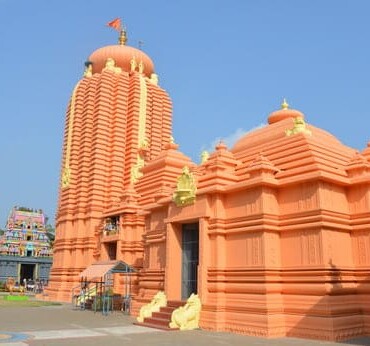
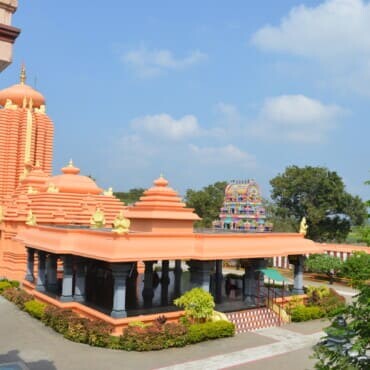
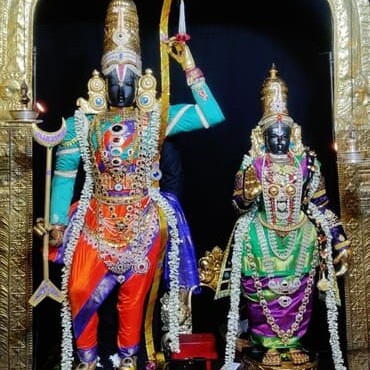
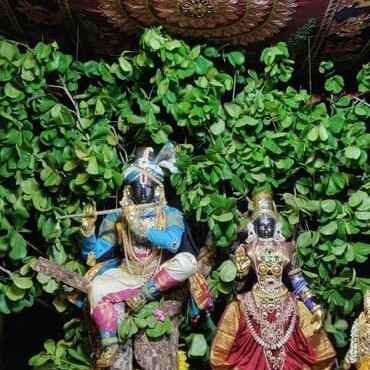
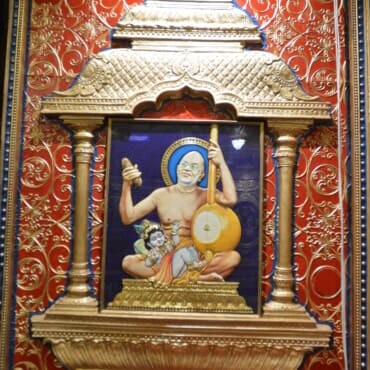
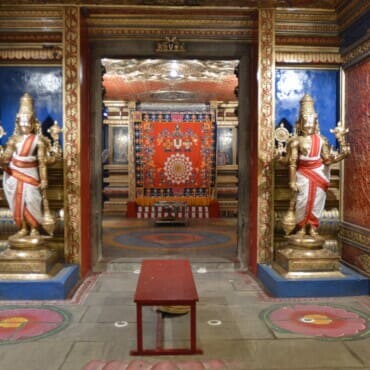
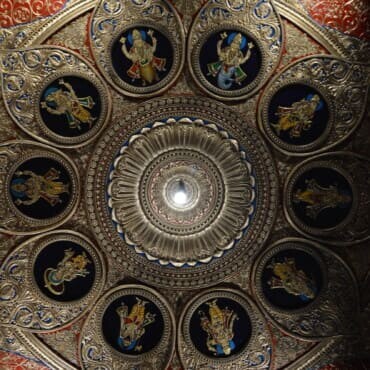
Raja Alankaram – Decorated as a King
Every Sunday, Lord Panduranga is adorned with turban (head gear) like a Rajasthan Prince, with peacock feathers followed by makara kundalam (adornment of the ears). He is then anointed with kasturi tilakam on the forehead and garlands around his neck. A sword hangs by his waist. Beautiful Padhukas embrace his lotus feet.
Every Thursday, the Lord and his consort are given a Thirumanjanam (Abhishekham) with scented perfumes, milk, curd, honey, panchamritam, sandal paste and tender coconut water. On this day, one can see the Lord simply and elegantly decorated with silver armour Alankaram.
Venkatachalapathy-Alarmelmangai
Every single day, the Lord is decorated in a unique manner. On every Saturday of Purattasi Masam( 15th September -15th October), the Lord is seen with a silver armour (kavacham).
The adornments also include Shanka, Chakra, Kaustubam, Saligrama mala, Sahasranama mala, Goddess Mahalakshmi on the left side of his chest, an emerald pendant, sword in the hip, Makarakandi, Nagabharanam, the golden crown, Kasturi Tilakam on the forehead,with Peethambaram around his body.
Dressed as Venkatachalapathy, Panduranga strikes a regal pose. Along with him, Alarmelmangai Thaayar( Padmavati) is seated in a divine posture.Having the darshan of the Lord in the form of Lord Venkatachalapathi and Alarmelmangai Thaayar is a blissful experience.
Other Decorations
On the occasion of Tamil New Year’s Day, the deities are decorated in the form of Guruvayurappan with different kinds of fruits to mark the Vishu Kani festival. A variety of pulses and currency coins placed in front of him denote prosperity for the devotees.
Similar decorations are also made on other Argita Seva days.
Gokulashtami
On the day of Gokulashtami or Sri Krishna Jayanthi, the Lord is worshipped in the form of Venugopal .His attire is made up of a blue coloured cloth stitched with pearls and diamonds.
A Saptaham (seven day worship) is conducted in the Namaankirtana Mandapam following Gokulashtami, when the Lord is presented in different forms or postures, like the Govardana Giridhari, Rajagopala and as Parthasarathi who did Geethopadesam to save the mankind from falling in the trap of kama-krodha-lobha-moha-madha-mathsarya.
On the Mahapuja function day of Swami Haridhos Giri that falls on Avani( August 15-September 15th) Krishnapaksha Chathurdasi day the deities are adorned with sandalwood paste(Chandana Kaapu)as Radha and Krishna.
Arudra Pournami,in the month of Margazhi( December 15th-January 15th),marks the Aradhana function of Swami Gnanananda Giri. On this day Lord Panduranga and his consort are adorned with white butter ( Vennai kaapu).
Swami Haridhos Giri was born on Uttarathadi( Uttarabhadra) nakshatra in the month of Margazhi( December 15-January 15). To commemorate his birth nakshatra, a Rathotsavam is conducted every month on Uttarathadi nakshatra day with the Utsava Moorthy in a grand golden chariot. This Utsava Moorthy was worshipped by Swami Haridhos Giri.
The sacred tree
Inside the Pandurangan Rakhumayi temple complex, the Sthala Vriksham( sacred tree) is called Thamala Vriksham. The legend of this place dates back to the Puranas. When Sri Krishna played his divine flute under this tree in Dwapara Yuga, Sri Radha Devi heard it from Barsana( Radha’s birth place) and got united with him. This tree is seen only in three places – at Saketh in Uttar Pradesh, Sakshigopal in Orissa and in Thennangur, Tamilnadu. Devotees pray to this tree for fulfillment of their wishes and do pradakshina around the tree twelve times.
Daily and Weekly Poojas in Panduranga Rakhumayi Temple
1. Daily Poojas
2. Weekly Poojas
Daily Programmes

Daily Programmes in Panduranga Rakhumayi Temple
Temple is open every day from 6.00 A.M. to 8.00 P.M.
- 6:00 Suprabhatam
- 10:30 Prarthana and Deepa Jyoti
- 12.00noon – 4.00pm closed
- 6:30 Deepa Aradhanai
- 8:00 Panduranga Rakhumayi Temple Closes


